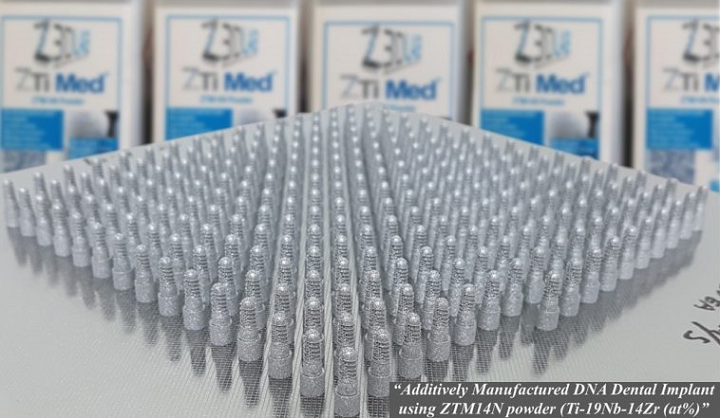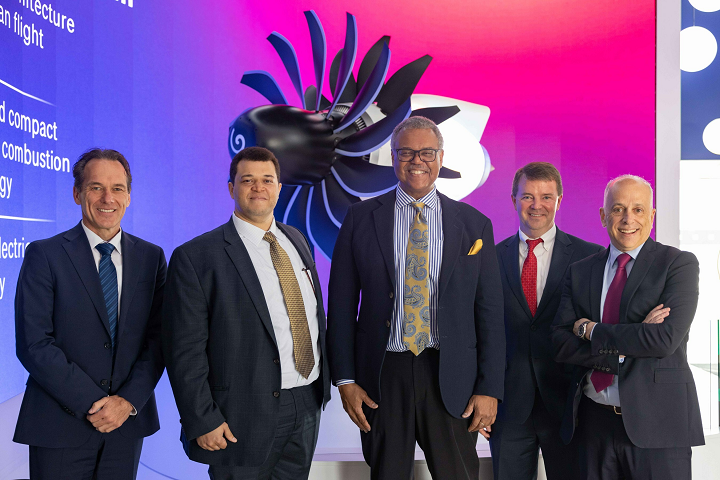We’re starting with maritime 3D printing news in today’s 3D Printing News Briefs, and then moving on to construction. There are several collaborations and partnerships to report on in regards to pellet extrusion 3D printing, an eVTOL propulsion platform, titanium powders, and 3D printed prosthetics access.
MPA Singapore-Funded Maritime 3D Printing JIP Phase II Ending
With the goal of proving technical capabilities and promoting the use of additive manufacturing in the region, the Maritime & Port Authority of Singapore (MPA) funded a Phase II Joint Innovation Project (JIP) in 2021, which included 3D printing and installing critical components on vessels and tracking their performance and usage. The JIP is now coming to a close, with news that nine 3D printed maritime spare parts were successfully installed and aced their field trials onboard vessels. The main members of the JIP— Ivaldi Group, DNV, Thyssenkrupp, and Wilhelmsen Ships Service—along with ship owners and OEMs, worked to find the answers to questions about cost barriers and technical aspects of critical parts certification, which have been barriers to advancement. Based on business case, end user pain points, and value, the team identified, designed, 3D printed, and installed these spare parts, printed out of metal and polymer. They ranged in criticality, and so were certified either by the manufacturer or DNV, with 3.1 and 3.2 inspection certificates according to EN 10204:2004 that confirm the necessary testing and inspection process were done properly.
“From DNV, we are excited for being part of this Joint Innovation Project (JIP) in Singapore, which aimed to identify and overcome the challenges associated with certifying critical parts, thereby facilitating the integration of additive manufacturing in the maritime sector,” said Dr. Sastry Kandukuri, Global AM Practice Leader for Additive Manufacturing at DNV Energy Systems. “Through the successful installation and certification of these crucial components on vessels during field trials, we believe that we have made significant progress in building trust among OEMs and end users. This serves as a testament to the immense potential that additive manufacturing holds for the maritime industry.”
Printed Farms & COBOD Complete World’s “Largest” 3D Printed Building
Florida startup Printed Farms, a COBOD International customer, used the BOD2 construction 3D printing system to complete what it calls the world’s largest 3D printed building. Known for building Florida’s first permitted 3D printed house in Tallahassee, this time Printed Farms 3D printed a luxury horse barn in Wellington, Florida, with a total floor area of 939 m2 and a height of 4 meters, measuring an impressive 47 m long and 25 m wide. This unique equestrian facility was designed to hold up under the extreme weather conditions that plague the region, including tropical storms and hurricanes, and a major focus was placed on occupant safety and structural integrity. 3D printing was a good choice for the project, as its versatility enabled walls that create a cavity and air gap for natural cooling. This marks another record for COBOD, which claims that its printers are the fastest (completing 3 buildings in 8 days in Oman), have fabricated the tallest building (9.9 m in Saudi Arabia), and now completed the largest 3D printed building.
“Printed Farms has done a remarkable job in completing this massive structure and the project demonstrates again how 3D printing is transforming the construction industry for the better,” said Philip Lund-Nielsen, COBOD Co-founder and Head of Americas. “COBOD is proud to be technology supplier to yet another record-breaking 3D printing project on US soil which comes only shortly after the completion of the US’ first 2-story 3D printed building in Texas, also using our BOD2 3D printer. We are especially proud to observe our 3D printers being utilized for a broad range of applications besides housing, which is the industry’s predominant use case. Our machines dominate this space already, but are in addition also used to print turbine bases, schools, office buildings, data centers, silos, and more – now that horse barns are added to the list.”
3D Systems & SWANY Speeding Up Adoption of Large-Format Pellet Extrusion

SWANY’s new demo center will include a 3D Systems EXT 1070 Titan Pellet printer to enable high throughput production.
In a new collaboration, 3D Systems and SWANY Co., Ltd. are working together to accelerate adoption of large-format pellet extrusion 3D printing in Japan. Established in 1970, SWANY is a product design company that’s cultivated all sorts of advanced production technologies, like 3D printing. It plans to open a new demo center this fall in Ina City, Nagano Prefecture that will include a 3D Systems EXT 1070 Titan Pellet printer (formerly Titan Atlas 2.5 HS), which is the first of its kind in the country and will be used to showcase efficient, high-throughput additive and subtractive manufacturing capabilities. SWANY will also provide 3D printing and design support services to the APAC region from its center, and work with 3D Systems to develop new printing parameters to allow for mass production of recycled pellet materials that can address applications in more sustainable ways using its UCWS; Upcycling Workspace initiative. EXT Titan Pellet printers, with their unique tool head options, offer a major reduction in material costs and a larger range of functional materials, which not only helps on the sustainability front but also makes them perfect for printing large-format parts.
“In the production of large plastic parts for our customers, we continually found ourselves challenged to produce molds with dramatic speed and in a cost-efficient way. As a result, we often couldn’t meet these requests and turned away business,” said Yoshihiro Hashizume, President and CEO of SWANY. “We believe that 3D Systems’ EXT 1070 Titan Pellet printer is the only tool that can overcome this challenge. Through our collaboration with 3D Systems at our new Demo Center, we are confident that the EXT Titan Pellet printers will facilitate a major change in Japan’s domestic manufacturing environment for mass production.”
MagLev Aero Chooses GE Additive for Ultra-Quiet eVTOL Propulsion Platform
Boston-based aerospace innovator MagLev Aero recently emerged from stealth with its proprietary MagLev HyperDrive aero propulsion platform. Supported by over 20 issued patents, the novel technology and platform will enable ultra-quiet electric vertical takeoff and landing (eVTOL) aircraft, and the company has chosen to work with GE Additive’s AddWorks consultancy team to help develop additive technologies and materials for HyperDrive. Its strategy is to collaborate with Tier 1 suppliers and major aerospace OEMs to help solve critical challenges in urban eVTOL business models, deployment, and practicality, and GE Additive is one of the first companies to be publicly announced as supporting MagLev Aero, which shows the potential of AM for eVTOL aircraft applications. MagLev Aero has a novel engineering approach, and its unique HyperDrive uses the fundamental principles that drive super-fast, ultra-quiet maglev trains, but with a circular rotor, which could increase safety and deliver more payload with less noise for high-efficiency eVTOL aircraft.
“The MagLev HyperDrive™ platform represents a transformative step in vertical lift efficiency and aircraft design,” said Rod Randall, MagLev Aero’s Co-Founder and Chairman. “By working with AddWorks’ world-class consultants and engineers, we are leveraging advanced technologies and materials to achieve optimal strength and stiffness at the lightest weight on our mission to open up ultraquiet electric air mobility to the masses.”
6K Additive & Z3DLab Partnering for High-Performance Titanium Powders

The medical implants manufactured with ZTM14N have an improved resistance to inflammatory species by almost 10 times vs other titanium alloys with a Bone Interface Contact BIC value of 95%
Sustainable AM material production leader 6K Additive, a division of 6K Inc., announced that it is partnering with French Z3DLab, a materials science technology company specializing in high-performance titanium powders for additive manufacturing. Together, the two will work to accelerate new advanced AM powders for medical implant applications, and additional material developments in the future for aerospace applications. 6K Additive will process Z3DLab’s proprietary ZTi (titanium zirconium) alloy powders through its UniMelt process, which uses scrap, revert, or used powder as feedstock to produce spherical, dense powders for AM. UniMelt delivers up to 100% yield, which makes it more commercially possible to develop new materials, and also helps create a circular economy. Z3DLab’s ZTi Powders—including its biocompatible ZTM14N with good strength-ductility ratio and exceptional elasticity—are used in powder bed fusion (PBF) and directed energy deposition (DED) systems, and aim to replace alloys currently used in medical and engineering AM applications.
“Our ZTM14N material is unique for the medical implant industry and has tremendous growth opportunity in the space. However, we cannot afford to suffer the yield loss that is typical in the atomization process during production. We will be burdening the cost unnecessarily for our customers,” explained Dr. Madjid Djemai, President of Z3DLab. “6K Additive’s UniMelt delivers the required high yields of highly spheroidized powder that enables us to cost-effectively deliver our material to the market. This partnership benefits not only 6K Additive and Z3DLab but also the customers we serve. I am looking forward to our next project in the aerospace sector.”
Victoria Hand Project, BASF Forward AM & UltiMaker Expanding Prosthetics Access in Ukraine
Canadian non-profit organization Victoria Hand Project (VHP) has partnered with BASF Forward AM and UltiMaker to expand high-performance prosthetics access in Ukraine. VHP has formed clinical partnerships in 11 countries and created a network of compassionate professionals, like UltiMaker and BASF Forward AM, who use 3D printing materials and systems to create affordable, customizable prosthetic arms for those in need. In January, VHP completed a successful pilot project in Ukraine, conducting initial training, setting up equipment, and demonstrating fittings at two partner sites. It is now working to make the partnerships in Ukraine permanent by training prosthetists and technology experts in Lviv and Vinnytsia to 3D scan, print, assemble, fit, and provide prosthetics on-demand, and its fundraising campaign will also fully fund prosthetic care for 100 Ukrainian amputees and lay groundwork for more. BASF Forward AM will contribute with its Ultrafuse PLA PRO1 material, which enhances the aesthetics of prosthetics and contributes to their functionality, and UltiMaker software and printers, with their stable functionality and strong construction, are easy to operate and deliver consistent, dependable results.
“By harnessing the print quality and mechanical properties of Forward AM Ultrafuse® PLA PRO1 in addition to the exceptional dependability from UltiMaker, Victoria Hand Project creates prosthetic hands that not only meet functional requirements, but also empower users,” said Michael Peirone, CEO of Victoria Hand Project. “These hands are not just tools; they become symbols of resilience, self-assurance, and durability in the daily lives of amputees.”
VHP is working to raise $200,000 to support its Hands for Ukraine campaign; donations can be made here.
Subscribe to Our Email Newsletter
Stay up-to-date on all the latest news from the 3D printing industry and receive information and offers from third party vendors.
You May Also Like
Gorilla Sports GE’s First 3D Printed Titanium Cast
How do you help a gorilla with a broken arm? Sounds like the start of a bad joke a zookeeper might tell, but it’s an actual dilemma recently faced by...
Nylon 3D Printed Parts Made More Functional with Coatings & Colors
Parts 3D printed from polyamide (PA, Nylon) 12 using powder bed fusion (PBF) are a mainstay in the additive manufacturing (AM) industry. While post-finishing processes have improved the porosity of...
$25M to Back Sintavia’s Largest Expansion of Metal 3D Printing Capacity Since 2019
Sintavia, the digital manufacturing company specializing in mission-critical parts for strategic sectors, announced a $25 million investment to increase its production capacity, the largest expansion to its operations since 2019....
Velo3D Initiates Public Offering in a Bid to Strengthen Financial Foundations and Drive Future Growth
Velo3D (NYSE: VLD) has been among a number of publicly traded 3D printing firms that have attempted to weather the current macroeconomic climate. After posting a challenging financial report for 2023,...



































